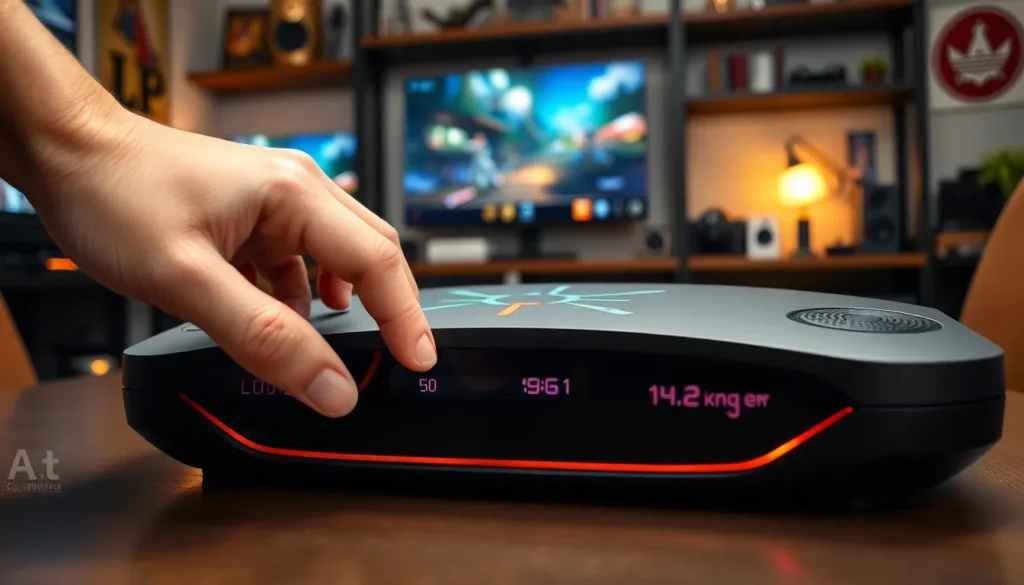Table of Contents
ToggleGamers know that power is everything, and when it comes to the Steam Deck, wattage control can make or break the gaming experience. Imagine diving into your favorite game only to be interrupted by battery woes or overheating. That’s where wattage control steps in like a superhero in a cape, ready to save the day.
Overview of Steam Deck Wattage Control
Steam Deck wattage control plays a vital role in enhancing the gaming experience. Achieving an optimal wattage setting can prevent battery drain issues and reduce the risks of overheating. Players benefit from customizing settings based on their gaming needs, which promotes efficiency and performance.
Controlling wattage directly affects the Steam Deck’s overall power consumption. Higher settings may improve graphic performance but often shorten battery life. Lower settings extend playtime but can limit performance capabilities. Finding the right balance remains essential for gamers who want both endurance and quality.
Utilizing wattage control features allows players to manage their gaming sessions more effectively. Gamers can adjust wattage settings in real-time, responding to demands from hardware and software. Custom presets enable players to optimize performance for specific games, ensuring a smoother experience.
Managing heat output is another crucial aspect of wattage control. High wattage can lead to increased heat generation, potentially harming internal components. Implementing wattage limits helps maintain temperature stability, thereby prolonging the device’s lifespan.
Each adjustment in wattage not only affects gameplay but also influences overall system resource management. Tracking performance metrics becomes easier through wattage control tools, allowing users to make informed decisions. As developers continue to enhance these features, increased flexibility will likely become available for players.
Enabling users to take charge of their device opens up new opportunities for enhancing comfort during extended gaming sessions.
Importance of Wattage Control in Gaming

Wattage control plays a vital role in optimizing the gaming experience on the Steam Deck. Adjusting power settings can enhance gameplay while addressing potential issues like battery drain and overheating.
Enhancing Performance
Optimized wattage settings improve gaming performance significantly. Increased wattage enhances graphics fidelity and frame rates, thus allowing gamers to enjoy demanding titles at higher quality. Customizable settings empower players to select specific wattage levels depending on their gaming needs. These adjustments ensure that players can balance performance with battery consumption effectively. Higher wattage provides immersive experiences but comes with shorter playtime. Players can switch to lower wattage for less demanding games, extending their sessions without compromising overall gaming quality.
Managing Heat and Power Efficiency
Controlling wattage directly impacts heat generation and overall power efficiency. Excessive wattage contributes to overheating, which can damage internal components over time. Maintaining an efficient power level minimizes thermal stress and prolongs device lifespan. Gamers benefit from monitoring temperature and consumption metrics through wattage control tools. Real-time adjustments enable them to manage heat levels during intense gaming sessions. Striking a balance between performance and thermal regulation helps keep the Steam Deck functioning optimally. Effectively managing power consumption allows for prolonged gameplay without risking device performance or integrity.
How to Adjust Wattage on Steam Deck
Adjusting wattage settings on the Steam Deck can significantly enhance gaming performance and battery life. Gamers can easily customize power levels to suit their gaming needs.
Accessing the Steam Deck Settings
Access settings through the Steam Deck’s main menu. Navigate to the “Settings” option and select “System.” From here, gamers can find the “Performance” section, which includes wattage control tools. Users can adjust the wattage slider to set power consumption according to preferences. Enabling frequency scaling helps optimize performance while managing heat output. Regularly checking these settings ensures that the device runs smoothly throughout extended gaming sessions.
Recommended Wattage Settings for Different Games
Recommended wattage settings vary based on the game’s demands. For less intensive titles, using 5–15 watts can maximize battery life while providing sufficient performance. In contrast, demanding games may require settings of 20–30 watts for improved graphics and frame rates. For competitive gaming, adjusting to 25 watts can offer a balance between power and efficiency. Each adjustment allows gamers to enjoy smoother gameplay without excessive battery drain. Prioritizing settings based on the specific game ensures an optimal experience and device longevity.
Tools and Software for Wattage Control
Effective wattage control on the Steam Deck involves various tools and software that enhance the gaming experience. Players can utilize both third-party applications and built-in features for optimal power management.
Third-Party Applications
Several applications facilitate advanced wattage control. For instance, software like MangoHud provides real-time performance metrics, allowing gamers to monitor temperature and power consumption efficiently. Another option, Steam Deck Tools, offers customizable wattage settings tailored to individual gaming requirements. Users often appreciate these tools for their ability to enhance gameplay while managing thermal output. Additional applications, such as FSR, improve performance through resolution scaling, balancing graphics and battery life. By utilizing these third-party options, players can achieve a personalized gaming experience, ensuring both performance and device longevity.
Built-in Features
The Steam Deck includes several built-in features aimed at wattage control. Accessing the “Performance” section in the settings menu serves as the starting point for adjusting wattage. Gamers can shift the wattage slider to find a balance between power and efficiency. Utilizing frequency scaling helps optimize overall performance while controlling heat generation. Moreover, gamers can set specific profiles for different games, depending on their demands. For instance, lighter titles may require 5–15 watts, whereas more graphics-intensive titles often operate best at 20–30 watts. These built-in adjustments significantly benefit gameplay while promoting better battery longevity and thermal management.
User Experiences and Feedback
Users report varied experiences with wattage control on the Steam Deck. Many appreciate how modifying wattage settings impacts their gaming performance significantly. Players often find that higher wattage settings enhance graphics but also deplete battery life quickly. Feedback emphasizes that balancing these settings can lead to a more enjoyable gaming experience with extended playtime.
Some users recommend keeping wattage between 5 and 15 watts for less demanding titles. This range maximizes battery life while maintaining adequate performance. For more intensive games, adjusting wattage to 20 to 30 watts becomes crucial for better graphics and frame rates. Competitive gamers often prefer 25 watts, finding it optimal for efficiency without sacrificing performance.
Additionally, players highlight the utility of third-party tools like MangoHud and Steam Deck Tools. These applications provide valuable real-time metrics, allowing for fine-tuned adjustments that cater specifically to user preferences. Built-in features also enable users to refine wattage management through the settings menu, simplifying the monitoring of temperature and power consumption.
Gamers frequently share insights about the importance of managing thermal output. Excessive wattage often leads to overheating, which can decrease device lifespan. Many highlight the benefit of selecting wattage profiles tailored to specific games, enhancing overall performance while minimizing thermal stress. Monitoring tools facilitate this process, contributing to a personalized gaming experience that prioritizes both efficiency and durability. Overall, user feedback reveals that effective wattage control is essential for achieving a balanced gaming experience on the Steam Deck.
Effective wattage control on the Steam Deck is vital for an enhanced gaming experience. By adjusting wattage settings players can significantly improve performance while managing battery life and thermal output. This balance allows for longer gaming sessions without risking damage to the device.
Utilizing tools like MangoHud and Steam Deck Tools empowers users to monitor real-time metrics and make informed adjustments. With the right wattage settings players can enjoy demanding titles at higher graphics fidelity while still extending their playtime. Prioritizing wattage management not only enhances gameplay but also contributes to the longevity of the Steam Deck, ensuring it remains a reliable companion for gamers.







